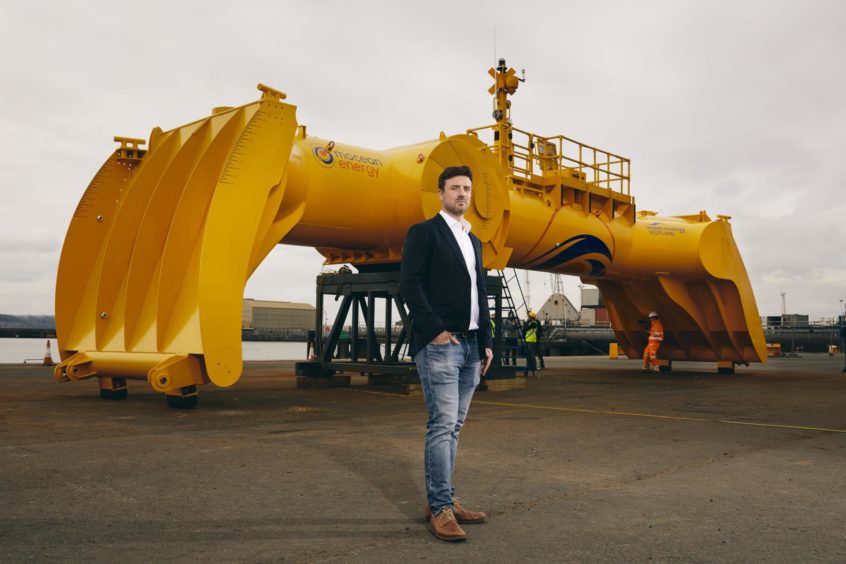
Integrating renewables with oil and gas operations will be fundamental to cutting emissions and maintaining the North Sea’s social licence to continue producing hydrocarbons.
Several options are presently on the table to help the industry hit its net zero goals, including carbon capture and storage (CCS) and platform electrification.
And a Scottish wave energy firm is hoping it will be able to deliver another solution to help revolutionise subsea operations in the coming years.
Mocean Energy’s 38-tonne Blue X wave energy system is due to leave Aberdeen for Orkney on May 9 where it will undergo testing at the European Marine Energy Centre’s Scapa Flow site.
The prototype, which was fabricated in Fife, will then be moved to the large-scale Billia Croo site for the “remainder of the summer”.
It’s eventually hoped that the wave system will be used to power things like subsea tiebacks, helping North Sea firms to reduce their operational emissions.
Cameron McNatt, Mocean’s founder and managing director, said: “It’s really about proving the technology works the way we’ve said it will and validating our models.
“The device is based around heavy numerical modelling – we developed software that found this new, optimised geometry for wave energy.
“Blue X has got big sloped wave channels. That feature increases the forces and changes the overall dynamics of the system so that it generates more power.”
As well as measuring its performance, Mocean is also exploring how well the system, which has been designed to cut through big waves, copes with “extreme conditions”.
If successful, the project, which is backed by more than £3 million from Wave Energy Scotland, will enable the development of Blue Star, the Edinburgh-headquartered firm’s subsea oil and gas offering.
The next generation system will provide green energy to remote equipment, including control systems and remotely operated vehicles that are typically powered by “very expensive” umbilical cables.
McNatt, who has a background in naval architecture and previously wrote code to develop ship simulations for the US Navy, said: “There’s also a lot of embedded CO2 in the subsea cables and the operations for installing them are very emissions intensive.
“A lot of the remaining oil and gas fields run on fine financial margins and are often very remote, meaning the tiebacks and umbilical cables need to be longer.
“What we’re proposing is to provide the power needed locally using renewable energy systems.”
He added: “It’s not just about oil and gas tiebacks. Another application Blue Star could be deployed in is CCS tiebacks. That’s a market that needs all the same equipment.”
As part of its work to develop this renewables solution for offshore operation, Mocean, which employs 14 people, four of which are based in Aberdeen, has teamed up with several other firms to help make Blue Star a reality.
Alongside EC-OG, Harbour Energy, Modus, OGTC and Baker Hughes, Mocean will build the subsea kit for the emissions slashing system, ahead of plans to test it offshore early next year.
McNatt said: “Blue X will be connected to an umbilical that will run down to some subsea equipment. That includes a battery system and communications gateway developed by EC-OG, subsea electronics modules provided by Baker Hughes and a residential autonomous underwater vehicle provided by Modus.
“Harbour Energy is the sponsoring operator partner, providing input and setting out what they need to see in the testing.”
Work to fabricate the subsea equipment is expected to ramp up later this year once testing of Blue X is completed.
McNatt added: “It’s really been great to have Harbour Energy and Baker Hughes on board. Our relationship with Harbour, formerly Chrysaor, goes back to 2019 when Mocean took part in the OGTC TechX business accelerator – it has been very supportive of us.
“Getting to this point and having Harbour and Baker Hughes on board really helps to give our technology a lot of credibility and bring in interest from other potential customers and partners.”
Recommended for you

